Porcelain Insulator News
by Jack H. Tod, NIA #13
Reprinted from "INSULATORS - Crown Jewels of the Wire", November 1980, page 24
Photo at the right is of a Locke U-418 and copper fog
shroud (via Robert Chiantelli of Monterey, Calif.). Photo below shows a number
of different fog bowls, all from the California coastal areas, and all in the
collection of Richard A. Peterson of Sacramento.
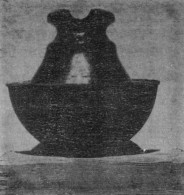
The top three are all O-B, and
the right-hand one of these is a modern version of the U-849 shown in the
Universal Style Chart.
As always, the photos by Richard (both these) are of
excellent quality.
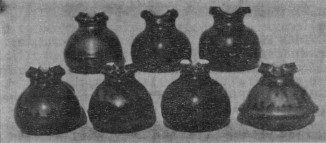
Dear Jack:
In the August column you made reference to
a patent on an in-line "dry spot" insulator. That is of interest to
me, since I acquired a group of six which I was told were for the purpose of
eliminating crosstalk. I'm enclosing my check for your "Electrical
Porcelain" book, but I would also appreciate any other info you have on
these dry spots. Do you know of anyone who has for trade a fog bell or a fogbowl
insulator?
J. A. Letcher
407 Shawnee Pl., Huron, OH 44839
- - - - - - - - -
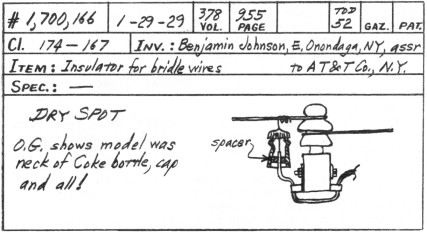
The above card from my
patent file shows data and sketch from the patent office Official Gazette on the
dry spot patent mentioned in the August CJ column. Needless to say, the Coke
bottle/cap would work just splendid as drawn up by the A T & T engineer and
draftsman for the patent application, and it may have been their inspiration.
Any subsequent production items would have embodied the basic principle but
would have been fabricated of glass or porcelain in a design more suitable to
production than whittled down bottles.
We ran this same patent card in the Feb
1977 CJ column (pages 20-21) together with excerpts from a 1934 O-B catalog
showing a couple of versions they made of petticoated porcelain tubes.
If the
gadgets you have resemble this design principle, then you undoubtedly have some
in-line dry spot insulators.
Jack
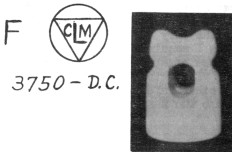
Dear Jack:
I got this white porcelain
item at the Herkimer, N.Y. show, and I'm 99% sure it's foreign unless you know
better.
It's 2-5/8" across the base, 3-5/8" tall, green ink underglaze
marking (as above). The pin hole is 1" diameter and only 1" deep, 3
large, widely spaced threads that go the whole depth. There are two funny
vertical notches each side of the pin hole and which also go full depth of the
hole. Can you help me with any information an this item, and especially the
marking -- whether or not this is a foreign insulator?
Marilyn Albers, NIA #541
Houston, Texas
- - - - - - - - - -
Dear Marilyn:
This in a "primary circuit wireholder",
or at least part of one (see page 57 of my book "Electrical
Porcelain"). As manufactured, these come with a lag screw or a threaded
stud which is leaded into the base hole. Someone obviously put your specimen in
an oven to melt the lead and remove the lag screw. Makes a nice paperweight, but
also removes it from the as-is insulator category?
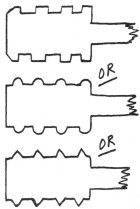
Obviously the smooth base
hole must be prepared in some fashion where the leaded-in mounting screw will
not pull out under a severe strain. One method is to use a "sanded
hole" -- porcelain "sand" applied to the surface of the hole before
firing. But more commonly the hole is just disfigured in any number of fashions.
One method is to insert a flat metal tool similar to the sketches at the right,
give the tool a half turn twist, then retract it, This makes the annular rings
(not threads) for the lead to grip -- and is also the reason for the remnant
vertical scourings you see in the base hole.
You can start melting out the lead
from large batches of nice wireholders if you're curious about the method used
by the factory to achieve the desired effect. After you've settled your
curiosity, the "insulators" won't be any good for your collection, but
you can sell the lag screws for scrap iron, and the porcelain parts will make
dandy slingshot missiles in event we're ever attacked by little men from Mars.
I've seen the Circle-CLM marking before, but can't attribute it. It's so
similar to the Line Material Co. trademark, it could be connected with that, and
especially since L-M had dozens of patents on various wireholders. The green
underglaze marking is unusual for U.S. poleline insulators but not for those
made in Canada. If you somehow manage to put all that together and come up with
Canadian Line Material Co., that's attributable to your own crystal ball, not
mine!
Jack
Dear Jack:
I recently went through a whole pile of discarded utility
company junk and ran across the following porcelain insulators. I'm not sure how
rare these are, but I know they're not run-of-the-mill.
- U-660A Ohio Brass Co.
marking, yellow glaze
- U-52A Unembossed, white glaze
- U-397 P.P. Inc. marking,
white glaze
The utility company foreman said the yellow O-B units were obtained
on special order back around 1965, but he had no idea why they were ordered,
since he wasn't employed there until some years after that.
Joe Maurath, Jr.
Abbington, Mass.
- - - - - - - - -
Dear Joe:
As I've pointed out numerous times, and also in
recent columns in CJ, collectors can find some very unusual items and real
goodies in the "junk" utilities have in storage or are just getting
ready to pitch out. The ones you found are further proof of this.
The U-660A by
O-B also was made in cobalt blue, and as "colors" go in these larger
cables, I'd guess either the yellow or blue would be a $5 trade value at most
shows.
Most of the telephone styles are scarce or unknown in glazes other than
brown, but there are exceptions, including the white U-52A exchange style. It's
a $1 to $2 trade value from my experience.
The U-397 has always been a scarce
style, and I think it's even better than the $12 we showed in the consensus book
value for brown. I've never even heard of one in white before, and I think
anyone collecting "whites" would chase this one!
Jack
Dear
Jack:
Regarding the attributed Circle-L marking on the rack spool reported in
the July 1980 column (page 32), hadn't you already attributed that marking to
Leviton Co. of Chicago way back in the November 1972 issue?? May I say though
that your batting average an attributions, as well as you entire researching
efforts are truly remarkable!
Now may I ask a question that I feel will be of
special interest to glass collectors? Milholland's book lists a very rare and
peculiar insulator, the CD-134.6, and the embossed date on this insulator
corresponds to a like date listed on page 165 of your book "Electrical
Porcelain" under your Class 60 (Tie-wire clips, clamps and bails), the
patent being issued to H. Rappleye.
Would you comment -- is it a coincidental date
for two different insulators? Could a bail have been applied to the CD-134.6,
etc.? If you have any additional info on this, I'd appreciate it to satisfy my
curiosity.
Wendell M. Hunter, NIA #567
DuBois, Pa.
- - - - - - - - - - -
Dear Wendell:
Quit swinging
at those low curve balls; you just struck out again! Leviton's trademark is
Circle-L, but they don't make pole line equipment. They have always made
"wiring devices", the various gadgets concerned with you plugging in
and switching on your table lamps. I've never been able to attribute the
"L", Triangle-L and Circle-L markings commonly seen an secondary rack
spools and wireholders.
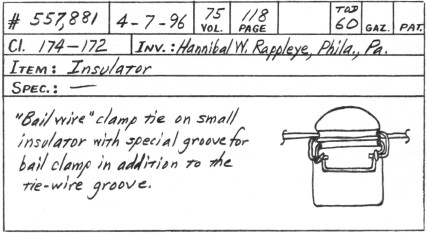
First, I presume the 4-17-96 listing in the Milholland
Third Edition is a typo error and that the specimens are embossed April 7, 1896
as you infer. As you can see from the card from my patent file (above), the
4-7-96 Rappleye patent seems to indicate use of an insulator with two closely
spaced grooves such as the CD-112.4, but I'll admit the oddly shaped crown and
wire groove brow of the CD-134.6 could be related to a bail wire scheme.
Why guess though? Wouldn't it be simpler for interested glass collectors to just
go to the library someday and thumb through the patents in the 4-7-96 Official
Gazette and see if there is any patent there which would fit the CD-134.6
specifically (only hundred pages or so, only ten minutes work)? I did this on
many porcelain insulators where the patent date was found on specimens, but I
just didn't have the interest or energy, to do it on all the various glass
insulators. If you can't locate any patent in the 4-7-96 O.G. letter patents or
design patents which would fit the CD-134.6, then maybe it was meant for use
with the Rappleye device.
Jack
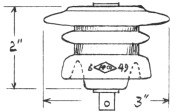
Dear Jack:
I'm enclosing a sketch of a clear
glass railroad insulator which was lying on the ground next to an out-of-service
railway. The rod and rubber sleeve going up the middle of it are removable. The
skirt marking is  . Is this insulator common, rare, or whatever? . Is this insulator common, rare, or whatever?
Gene DeVaux
6812
Vermont
Raytown, MO 64133
- - - - - - - - -
Dear Gene:
This insulator is not for special railroad
use. It's an insulating spool for a "Case" mid-span transposition
bracket insulator, and you can see these in use on many ordinary communications
lines -- mainly cross country phone lines.
These glass spools are common in
collector circles now that so many cross country phone lines have been
dismantled in recent years, and they are CD-1049 in Woodward's Consolidated
Design Chart. I am unfamiliar with the Diamond-AP CO marking, but glass
researchers can probably attribute it. Although the insulator is well known to
collectors, some of the following information may be new to readers.
The
several patents on these were granted 11-30-48, inventor Rogers Case, Orange,
N.J,, assignor to Transadean Associates, Inc., New York City. The patents are
listed on pages 158-159 of my book "Electrical Porcelain" under my
Class 46, "Transpositions, all types", and brief data are as follows:
- #2,455,227, two rotatable spools on a bar-type bracket between the conductors of
the line pair.
- #2,455,228, four rotatable spools on a square-shaped mid-span
spider bracket casting.
- #2,455,229, similar #228 above except for fixed mounting
on a support (namely, on the crossarm).
A later patent, #2,655,553 of 10-13-53,
also by Rogers Case, covers the addition of strengthening gussets added to the
arms of the casting, but without change otherwise.
The spools on the
four-insulator "spider" are secured by metal dowels and cotter pins,
plus a piece of heavy rubber tubing to cushion the glass away from the metal
pin. The spools on the two-insulator design are held by studs in the ends of the
cross plate.
In 1973 the president of Porcelain Products Co. (Carey, Ohio) told
me that the company was involved in making porcelain spools for these
"Case" brackets in their early development and manufacture. I can't
recall having seen any porcelain petticoated shackle-type insulators that looked
like they were meant for "Case" brackets. The only ones I've seen are
clear glass such as yours. If the "49" in the marking on yours is a
year date, this would be early production for these insulators. Later ones also
have rounded grooves instead of the flat groove bottoms as you indicate in your
sketch and as shown in the Milholland book photo.
Jack
| 